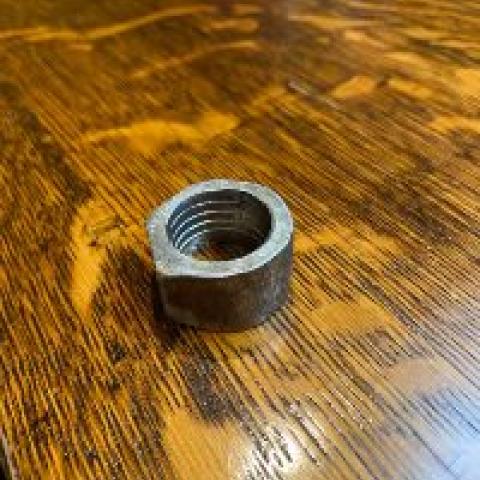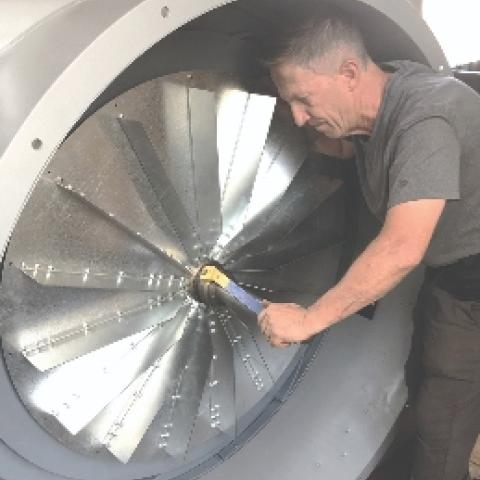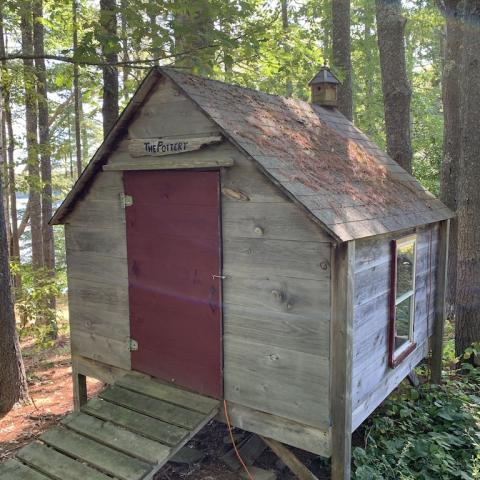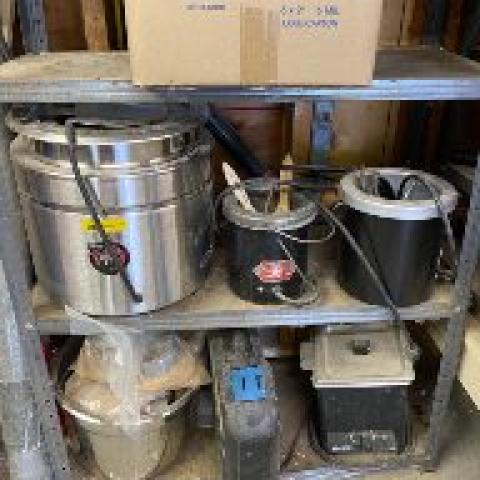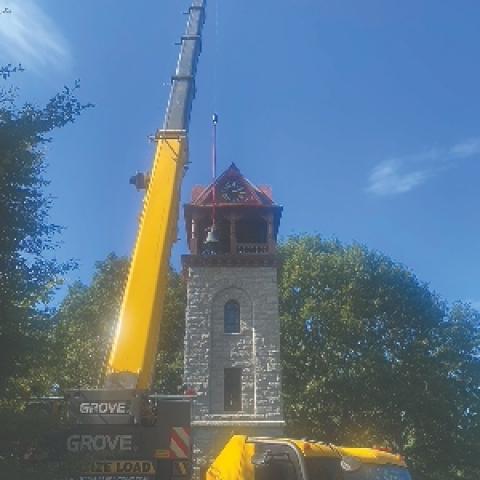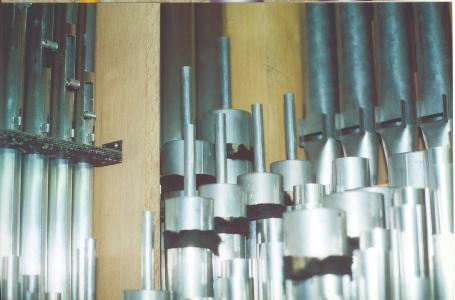
“It went zip when it moved and pop when it stopped. . . .”
In 1962 American songwriter and folksinger Tom Paxton wrote and recorded “The Marvelous Toy,” a nonsensical song with the catchy refrain that continued, “And ‘whirr’ when it stood still. I never knew just what it was, and I guess I never will.” As I was working out this essay in my mind’s ear, the song popped into my head, and I quickly found a raft of YouTube video performances including Tom Paxton himself singing with his grandson Sean Silvia, and the ubiquitous cover recording by Peter, Paul, and Mary released in 1969. The more you know about a machine, the easier it is to care for.
My colleague Amory and I were on the highway together—I was at the wheel, and Amory was half asleep in a highway-induced reverie when we passed a large truck whose trailer was a huge complex dedicated machine. Amory wondered half to himself, “What kind of machine are you?” I have always been fascinated by machines, what they do, how they work, and how to care for them.
I had a learning moment as a teenager mowing the lawn when the grass chute clogged. I stopped the engine, turned the mower over, cleared the clog, set it right side up, started it up, and continued mowing—for about thirty feet, when the three-and-a-half horsepower Briggs & Stratton engine stopped with a bang. While the mower was upside down, the motor oil ran out, and the engine ran about twelve seconds before it welded itself solid. It was like the proverbial customer in the auto parts store asking for a longer dipstick: “Mine doesn’t reach the oil anymore.” The other day, as Wendy and I were leaving our house in Maine to be gone for more than three weeks, I checked the oil in the backup generator and topped it off.
You are going to leave a parking space. You start your car’s engine, check the mirrors and back-up screen, put the transmission in reverse, and start the car moving backwards, steering so you wind up parallel with the curb. While you are still moving backward, you drop it into drive, the car gives a thud, and you start moving forward. At least that is what you do if you have no idea how the transmission (whether manual or automatic), universal joints, differential, crankshaft, and piston rods work. By changing the direction of your travel while the car is in motion, you have put excessive torque on all those critical parts and diminished the working life of your car’s drivetrain unnecessarily.
Try this: put the car in reverse, back out of the spot turning parallel to the curb, come to a complete stop as you move the gear shift to neutral, then shift into drive and start moving forward. No thud, no thump, no excessive torque, and you go merrily on your way.
Speaking of motor oil, I believe it is smart to let the engine run for thirty or forty seconds before you put the car in gear. When the engine is not running, all the oil is sitting in the oil pan at the bottom of the engine. When you start it, the oil pump pumps the oil to the top of the engine where the critical cams are opening and closing the intake and exhaust valves of the cylinders. If you put a load on the engine by moving the car before the oil is distributed throughout, you are adding unnecessary wear. Take a nice breath before you start rolling, and your camshaft will thank you. Have you ever noticed a light clattering sound just after starting the engine on a cold morning that goes away after a few seconds? That is the camshaft moving those valves, waiting for the oil to find its way to the top of the engine. I drive about 35,000 miles a year, and I have run six cars past 175,000 miles, three of those past 250,000.
After my parents retired to their home on Cape Cod, my tween-ish sons discovered that when you turned the faucets of the first-floor bathroom sink on, then off abruptly, you would get a loud clatter from the pipes within the walls. (I guess the plumber ran out of pipe clamps.) I told them how the rattling could lead to leaking joints hidden in the walls, but my mechanical wisdom fell on deaf ears. My older son Michael is as interested in all things mechanical as I am, and he grew into a career as a fabricator with superior welding skills and a vast knowledge of fasteners and connectors. He once described a project that required interior welding in eighth-inch stainless steel tubing. He reminisced about the banging of his grandparents’ plumbing, “We really were jerks, weren’t we?”
§
Like millions of American children starting in 1969, my sons grew up watching Sesame Street, which included feature segments about how things are made. I remember a montage of scenes from a Crayola factory showing how crayons are made, but the real standout was filmed at the Teddie Peanut Butter factory in Everett, Massachusetts, and featured the 1920s-flapper-style song by Joe Raposo, It Takes a Lot of Little Nuts to Make a Jar of Peanut Butter. The video flips from one machine to another as peanuts are roasted, ground, “a little salt, a little sugar makes the goo taste really good and keeps it pumping through the pipeline like a peanut-butter-pumper should.”
How do they shell those billions of nuts for peanut butter, or those big jars of shelled pecans, walnuts, or heaven help us, Brazil nuts. It is a small triumph to free a Brazil nut or pecan with a standard-issue nutcracker without chipping or breaking it. Jasper Sanfilippo (1931–2020) worked in his father’s nut business from the age of nine until 1963 when his father passed away. Jasper had a degree in mechanical engineering, and he developed high-volume machines for shelling all varieties of nuts. His company acquired the Fisher nut brand in 1995, which quickly became the best-selling brand of shelled nuts in the United States. You can still see his name on the back of any Fisher nut package.
His nut fortune allowed him to pursue his passion for machines, especially automatic musical instruments along with steam engines and locomotives, gramophones, carousels, slot machines, and penny arcades. His grand house in Barrington Hills, Illinois, Place de la Musique, is still operated as a museum that is used for charitable events and, predictably, conventions of various organizations devoted to the pipe organ. There is an immense Wurlitzer theatre organ at the heart of the collection. I was particularly fascinated by the machines that played four violins simultaneously. The violins are mounted upside down and arranged like a compass—north, east, south, west—and a circular bow surrounds and plays all four instruments at once. There are dainty metal padded fingers to damp the strings along the necks, little mechanical marvels adjusted by fractions of millimeters for correct tuning of every note.
Console etiquette
If you are an organist for a church or university, you are likely to be responsible for the care of the organ, a complex and sophisticated machine that is subject to mechanical failures and sensitive to climate changes. If you know a little about how it works, you can protect it from unnecessary wear and tear, just like sparing the drivetrain in your car by not changing direction abruptly.
Years ago, I maintained a simple little organ in Lexington, Massachusetts, that was notorious for dead notes in the pedalboard. The organist was an elderly woman with luxurious long, thick gray hair who kept a hairbrush at the console, and part of our routine was to pull out the pedalboard and sweep up the great clumps of hair that were interfering with the contacts. We called it the hairball organ.
Do not wear street shoes when you are playing the organ. Gritty bits of sand and debris will wreck the hard finish on the pedal keys and gather as abrasives on contacts, felt bushings, springs, and guides. You might be tracking water, snow, or heaven help us, salt. If you have ever left salt in a silver salt cellar, you know how salt corrodes silver. If your pedalboard is less than thirty years old or has been rebuilt in that time frame, your pedal contacts are likely made of silver. Salt from your street shoes means dead notes.
Organists have asked me many times whether it is okay to stand on a pedalboard. Don’t. There are some obvious variables. An antique pedalboard is likely to be more delicate than a modern one. Some builders are known for producing especially sturdy pedalboards. In my experience Casavant gets the prize. Theirs are frightfully heavy and very robust. I am a heavy guy, and I am certain I could stand safely on a Casavant pedalboard. But my weight or yours standing directly on the pedal keys is far more downward force that we generate by simply playing, so we would be crushing the felt down-stops (ultimately increasing the travel of the pedal keys) and pushing the contacts or tracker action past their normal “on” position (ultimately spoiling their adjustment). And should you fall through, you will cause terrible damage requiring expensive repair.
I once commented to an organist about the big coffee cup sitting on the stopjamb while he practiced: “If that ever fell into the keyboards . . . .” I got a huffy reply, but a few days later it was a contrite phone call. The cup was full, and the coffee was sugary. The organ was in a big, busy church, and we did not want to miss a Sunday, so I took the keyboards to my workshop one at a time, took them all apart, cleaned everything, and replaced several octaves of guide-pin bushings. That was the end of the coffee cup habit.
Our furry friends
My mentor John Leek was a first-generation Dutch immigrant who was friends with a gaggle of guys who worked for Flentrop. When I was working with John in the 1970s and 1980s, we did a lot of work for Flentrop, especially installing new organs. Hans Steketee, then president of Flentrop, came to John’s place for dinner and a shop visit, and John and I showed him a half-dozen reservoirs that we were releathering, telling him that we did a lot of that kind of work. “What do you do, put mice in the organs?” he asked. Have you known an organist who might leave half a donut on a napkin on the console keytable? Rodents like donuts. Please do not bring food to the console.
When I was a teenager, I practiced in a church in Yarmouth Port, Massachusetts, on an organ built by William H. Clark in the Swedenborgian Church. There was a terrible bang from inside the organ late at night that had me jumping out of my proverbial skin. The minister had set a Havahart trap inside the organ and caught his raccoon. I wonder how many nights that raccoon was lurking inside the organ while I rattled away at the keys. The tracker action for the Pedal Bourdon went across the floor. I imagine that would have been like the Caribbean dancers who jump between pairs of poles rhythmically moving back and forth while being held close to the ground. I hope my teenage playing was rhythmic enough.
Keep your eyes open for signs of rodents in your organ. A particular favorite lair for little mousies is in between the keyboards of your organ’s console. Searching for a rattling sound in the keyboards, I have found messy trails and stashes of acorns on the keyboard behind the nameboard, another chance to imagine a manic dance for a little critter as the organist practices a wicked toccata. (Once when returning to our house in Maine after a while away, we found a stash of acorns in a pillowcase on our bed, a cozy but temporary home for a furry family.) Keyboard mice add to their comforts by harvesting the felt from capped pipes and keyboard bushings to make little multi-colored nests.
During a service call in Osterville, Massachusetts, a pipe was not speaking because there was an acorn inside it. There were well-marked trails through the organ, across windchests and across the tops of capped pipes (many of which were stripped of their black felt), and a mouse had dropped his acorn into the pipe. He was not complacent about his loss, going down to the rackboard and gnawing at the mouth of the pipe trying to free his nut, without success.
Aeolus, keeper of the winds
One of the most important tasks in caring for a pipe organ is lubricating the blower and keeping the blower room clean. In many churches, the blower is a heavy, dark monster lurking in a murky or dusty basement lair that is likely to be full of spider webs and the assorted creatures that maintain and frequent them.
It is best to keep the blower room clean, and you may be inspired to bring in a shop-vac, but I recommend a protocol for cleaning a blower room that ensures the blower will not blast loosened dust into the delicate mechanisms of the organ. You should leave this to your organ technician:
• Turn off the power to the blower to ensure it cannot be started during the process. There is typically a heavy cutout switch on the wall next to the blower.
• Seal the air intake of the blower with plastic and tape.
• Clean all the surfaces of the room with a vacuum cleaner. Use a bucket and mop on the floor. Use a cleaning agent with damp rags on the blower and ducts. (I like Simple Green.)
• Let the room sit idle for at least twenty-four hours to allow dust to settle.
• Clean the room again.
• Let the room sit idle for at least another twenty-four hours.
• Remove the plastic and tape from the blower air intake, being sure that no free dust enters the blower.
You can now start the blower, being sure that no dust is blown into the organ.
And most important:
Be sure that the organ is properly insured. The church’s insurance policies may be overseen by a parish administrator or a volunteer member of the property committee. Investigate whether the organ is clearly named in the policy. Many churches have a fine arts policy that covers musical instruments, stained glass windows, communion silver, and any other artwork that may be present. It is usual for an insurance carrier to require an assessment from a neutral pipe organ expert, someone other than your usual organ technician. The assessment and coverage should specifically be for the organ’s replacement value. In the case of a total loss, the organ could be replaced. In the case of partial loss due to fire, flood, vandalism, or even rodents, the insurance adjuster will negotiate with organbuilders and advisers to determine an appropriate settlement based on the replacement value.
The officers, organists, and members of many churches are blissfully unaware of the status of insurance coverage, leaving their organs at risk. It is the responsibility of organists and organ technicians to raise this issue.
§
When I was a kid, the television had rabbit-ear antennae, often festooned with tinfoil, and when the reception was poor (it was always poor), we would slap the side of the machine as if that would knock those delicate vacuum tubes into submission. I have watched organists jab hard at intermittent piston buttons and stop controls, thinking that would get them to work, when in fact that was the cause of the fault. All our machines are the product of human ingenuity as applied to the laws of physics. There is no such thing as a machine that works better when treated roughly. Be gentle with your machines, and they will serve you well.

